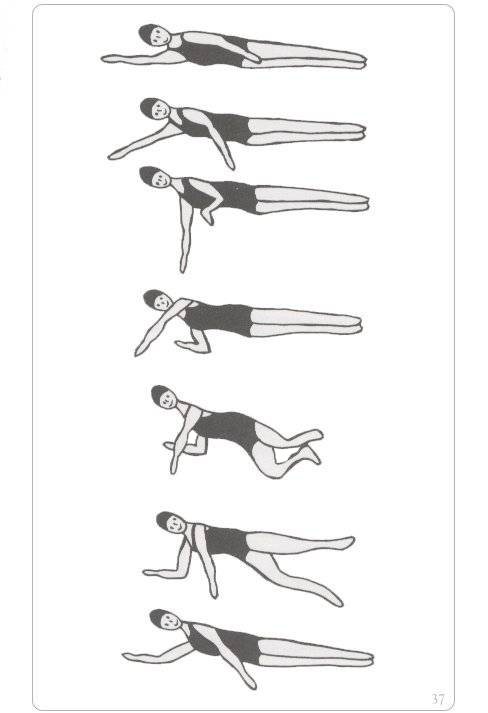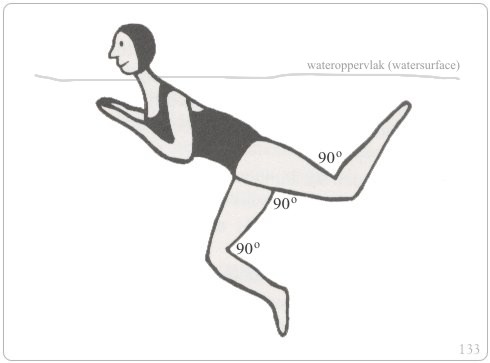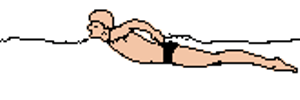PS: Swimming-strokes which are shown in bold
are being discussed on this page.
|
|
|
|
| BREASTSTROKE | ||
|
PS: Swimming-strokes which are shown in bold |
||
|
|
|
|
| Legend: | |
|
* |
= a difficult swimming-stroke to swim or impractical |
|
|
 |
|
|
||
|
|
This swimming-stroke looks like the breaststroke except that the body position is diagonal. The arms are brought in front of the body under water where the trailing arm makes a wide half pull-through and the leading arm a normal half pull-through. The legstroke is a modified frog-kick and the combination of the arms and legs is long. Moreover, a long gliding-phase is done. This is a very nice and comfortable swimming-stroke to swim. That is why we rated this swimming-stroke to 9 on a scale of 10. 
|
|
|||
|
|
|
|
|||
|
|
|
 |
|
|
|
Looks like the breaststroke. However, this swimming-stroke is swum with a particular legstroke, namely known as a vertical noshi-legstroke instead of a frog-kick.  One fragment of the Ryowa-Noshi |
|
|
|
|
|
|
|
|
|
 |
|
|
|
|
Looks like the breaststroke but it has a threestroke legstroke. |
|
|
|
|
|
|
|
|
|
|
 |
|
|
|
This swimming-stroke looks like the breaststroke but the body position is diagonal and the head is also held diagonal into the water. The arms are almost the same as with the breaststroke except that they are pulled through much further back. The legstroke is a modified frog-kick and the combination of the arms and legs is short. There is also a gliding-phase involved but this is only a short one. This is a simple swimming-stroke but not a pretty one. |
|
|
|
|
|
|
|
|
|
 |
Source: swim-city.com |
|
||||||||
Introduction
Introduction The differences between the breaststroke and the butterfly became bigger, just as the differences between the times. That is why they decided to seperate these two swimming-strokes and the butterfly as a single swimming-stroke became a fact. This happened in 1952. The Hungarian swimmer Tumpek was the first one who practised the dolphin legstroke. Because of this the butterfly became a more continuous stroke. The butterfly is, after the frontcrawl, the fastest swimming-stroke. The removal is less continuous than the frontcrawl because of the simultaneous arm-movement. Also the position in the water is less ideal, because the body moves too much in vertical directions. The function of the head in the butterfly is very important. The relatively extreme head-movement with regard to the trunk is very important. The body needs to follow this head-movement sufficiently to make the changing hollow-round-position feel allright. The timing of the head-movement on the arm-movement is decisive. The timing of the supporting leg-action has to be suitable for the hollow-round-position out of the armstroke and the head-movement. Butterfly is the only swimming-stroke at which the back plays an important role in the swim-movement. At the movement opportunities of the shoulders, neck and back are set high requirements. A relatively large physical strength is required; because of this the butterfly is unsuitable for long distances. 
The armstroke
The armstroke can be divided in the following phases:
A swimmer's below view.
1. Put in 2. Glide-phase 3. Pull-phase 4. Push-phase 5. The Lash out 6. Pull-over Pull-over:
The legstroke
Upbeat: Because the movement is executed with both legs at the same time, the hips go upwards during the downbeat. At the upbeat, at which the legs are stretched again because of the water resistance, the hips go down. So the position of the body changes continuously from hollow into round and back again. The body's position is waving. We can discover two moments on which an active damming legmovement starts:
Ad 1 : Ad 2 : Breathing The breath out takes place during the put-in, pull- and push-phase. Inhaling occurs via the mouth and breathing out via the mouth and nose. It is recommended to breath after every 2 armstrokes. As a result of this way of breathing, the frontal resistance is reduced to a minimum.
The movement of the head
Frequently made mistakes with the butterfly
|
|||||||||||
|
|
|
|
|||||||||